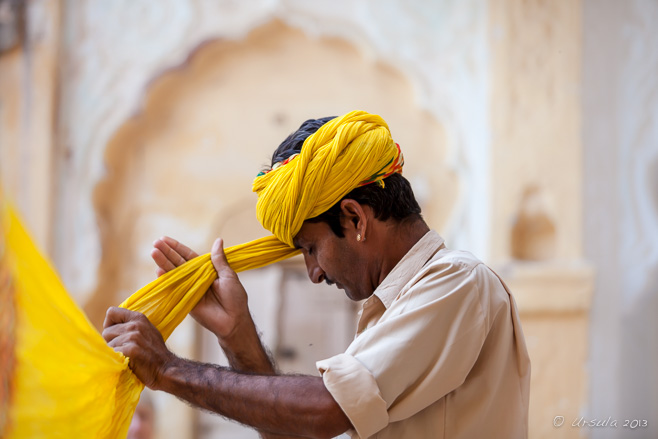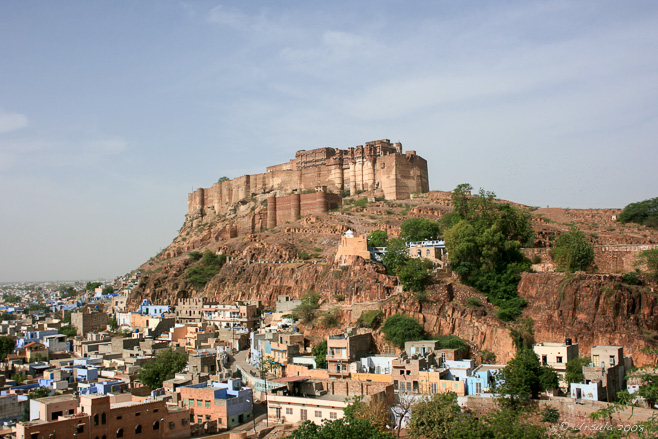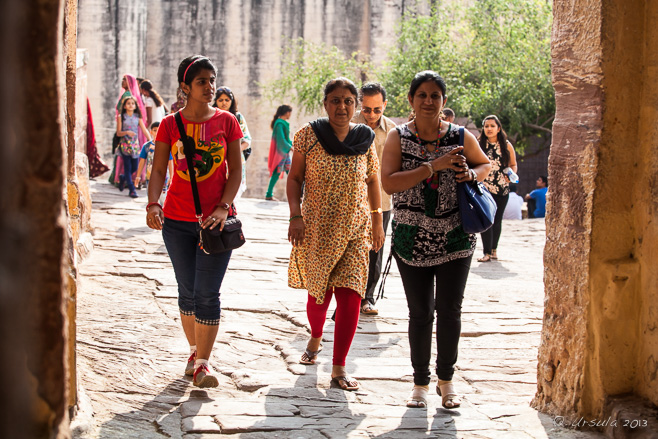
Tying a Turban
Rajasthan is known for it’s colourful turbans: the uniform turbans worn by the attendants in Mehrangarh Fort in Jodhpur are a case in point.
Rajasthan is known for it’s colourful fabrics: especially the “crowning” turbans of the men which hark back to the Rajput land-owners and rulers. Traditionally, the size and style of the turban denoted status and rank, and different colours were worn for different purposes, like weddings and celebrations, or during different seasons.
Holy men in white or saffron turbans are still a common sight across India, but in Rajasthan every village, region, or workplace has its own fashion or style.
The male workers at Mehrangarh Fort in Jodhpur wear a turban as part of their uniform. During one of my visits there, with photographer Karl Grobl and local guide DV, I was treated to a demonstration of their turban-tying skill. In the days of royal courts, young women were employed to tie men’s turbans for them, but today, most men take pride in tying their own – taking care that none of the 25 meters of fabric touches the ground.

Mehrangarh Fort (2008)
High (120 metres – 400 feet) over the blue city of Jodhpur, the ancient fortress of Mihirgarh (“Sun Fort” in Sanskrit) protected a number of palaces and now houses historical museum galleries.

Into the Shadows
At the entry to Mehrangarh Fort, Indian women wear a mix of modern and traditional clothing (Kameez – shirts or blouses – worn over Shalwar or leggings, with Dupatta multi-purpose scarves) in colourful fabrics. Of course, Saris are also common.

Traditional Musicians
However they tie them, the men working around Mehrangarh Fort wear the same turbans in yellow, with green and red accents.

Playing the Pipes
The Achkan, a knee length jacket, over trousers, completes their uniform.

Guard at the Gate

Man with a Hookah

Arches on the Corridor
The hallways and corridors of Mehrangarh Fort are beautifully balanced and delicately carved.

Tying a Turban
The brightly coloured turban cloths are 25 meters long, …

Tying a Turban
… so getting one neatly wrapped takes time and help.

Stating a Turban

Finishing a Turban

Turbaned
The finished product gets a pat-down…

Men in Turbans

Tying a Turban
One of the other men demonstrates a different style, …

Setting the Turban
… getting it well settled on his head …

Intricate Turban
… before flashing us a big smile.

Turban in a Window
The delicate filagree work around the windows is quite beautiful.

Moti Mahal (2008)
The Moti Mahal, or Pearl Palace, inside the Mehrangarh Fort, is a stunning testament to the glorious Rathore dynasty.

Elephant’s Howdah (2008)
One of the museum galleries contains some fine examples of the elaborate two-compartment wooden seats that were attached to the backs of elephants as chairs.

Turban – 2008
The colours and patterns of the fabric in the “uniform turban”…

Turban – 2013
… have changed over the years.

Cloth Merchant
In a gift shop, a salesman in an elaborately waxed moustache and beard shows off a different style of turban.

The Beard
Our hookah-smoking friend shows up at the exit to show off his beard to full advantage.

Mother and Daughter
A mother and child share a drink before leaving the fort.

On the Way Out
A family pauses on the walkway leading between the fort and Jodhpur below.

It’s a glimpse into a world with a completely different sense of sartorial style.
Namaste!
Pictures: 15April2008 and 06November2013

































.png)


[…] Thada After a visit to the nearby Mehrangarh Fort, we made a late afternoon stop to Jaswant Thada, the white marble mausoleum built in 1899 for […]